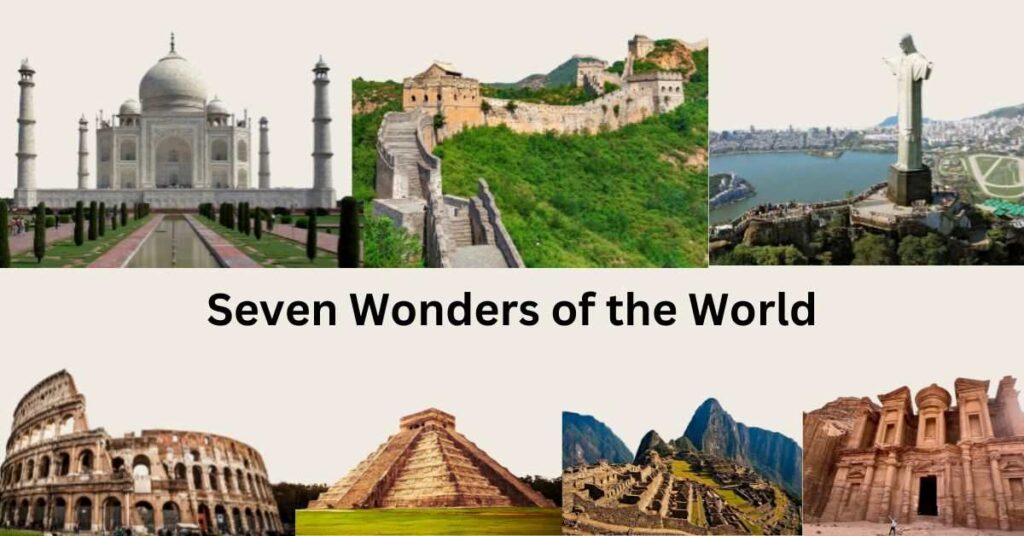The New 7 Wonders of the World are the most remarkable man-made structures on Earth, chosen by a global vote of more than 100 million people. These structures are marvels of engineering and architecture, and they demonstrate the best of human creativity and ingenuity.
New 7 Wonders of the World: The New 7 Wonders of the World is a list honoring the seven most extraordinary man-made structures on the planet. Compiled by the New 7 Wonders Foundation, a non-profit organization focused on preserving and promoting cultural heritage, the winners were selected through a global vote with the participation of more than 100 million people.
According to the New 7 Wonders of the World, there were 21 finalists for these positions. As Bernard Weber, Founder and Chairman of New7Wonders mentioned: “Over the years, the man-made New 7 Wonders of the World campaign continued to grow, from a grassroots idea to a movement that attracted millions of voters. 2006 New7Wonders World Tour -2007, during which time I visited 21 finalists with my team, resulting in increased votes and participation. Votes, emails, photos and videos came in from everywhere above that The New7Wonders global movement celebrated the results of the world’s first global voting campaign on 7 July 2007, when the results of more than 100 million votes were announced in Lisbon and 7. Official new wonder of the world announced.”
READ| Top 7 largest aircraft in the world
What are the new 7 wonders of the world?
The new 7 wonders of the world are as follows:
Related stories
| Question | Location |
| Chichen Itza | Mexico |
| Colosseum | IDEA |
| Christ the Redeemer | Brazil |
| The Great Wall of China | China |
| Machu Pichu | Peru |
| Petra | Jordan |
| Taj Mahal | India |
1. Chichen Itza, Mexico
Source: Off-road travel
Chichen Itza is a notable ancient Maya city located on the Yucatán Peninsula in Mexico. It was one of the most influential and prosperous centers of the Maya civilization during the Classic period (250-900 AD), playing an important role in politics, culture and religion. The city boasts a number of awe-inspiring structures, each offering a glimpse of the architectural and cultural sophistication of the Mayans.
Among the most iconic landmarks are the El Castillo Pyramid, a massive step pyramid that is a testament to the Mayans’ profound understanding of astronomy, and the Temple of the Warriors, a monument The grand structure is decorated with columns and carvings depicting Mayan gods and warriors. and the Great Ball Court, the largest and most impressive of its kind in the Maya world, where ceremonial ball games took place.
The well-preserved ruins of Chichen Itza continue to attract tourists and scholars alike, providing valuable insights into the Mayan civilization.
READ| Top 5 greenest countries in the world
2. Colosseum, Italy

Source: National Geographic Education
The Colosseum, a giant amphitheater nestled in the heart of Rome, is a testament to the grandeur and power of the Roman Empire. This iconic landmark, built in the 1st century AD under the Flavian emperors, is the largest amphitheater ever built and remains one of the most recognizable symbols of Ancient Rome.
Originally known as the Flavian Amphitheater, the Colosseum is an engineering and architectural marvel. Its elliptical structure, measuring 620 feet by 513 feet, can seat 50,000 to 80,000 spectators.
The amphitheater’s design was cleverly crafted to facilitate quick entry and exit of such a large crowd, ensuring a seamless experience for all.
The Colosseum was more than just an entertainment venue; it was the stage on which Roman power and might were displayed. Gladiator competitions, where skilled warriors engaged in mortal combat, were the highlight of the games. The arena, with a carefully designed wooden floor covered with sand, was the place where fierce battles between gladiators, wild animals and even mock naval battles took place.
3. Christ the Redeemer, Brazil

Christ the Redeemer, a towering monument of faith and hope, stands majestically atop Corcovado Mountain overlooking the vibrant city of Rio de Janeiro, Brazil.
This iconic statue, one of the largest Art Deco sculptures in the world, has become a beloved symbol of both Christianity and Brazil’s rich cultural heritage.
Built between 1922 and 1931, the statue’s majestic appearance with its arms outstretched embracing the city below has captivated the hearts of millions. Its striking design, conceived by Polish-French sculptor Paul Landowski and built by Brazilian engineer Heitor da Silva Costa, is a testament to the collaboration between artistic vision and engineering prowess. art.
READ| Top 5 smallest states in the US by area
4. Great Wall of China

Source: Asia Travel and Leisure
The Great Wall of China, a testament to human ingenuity and resilience, is a series of monumental fortifications spanning the rugged terrain of northern China.
Built over centuries by countless workers, this architectural wonder symbolized the Chinese Empire’s determination to protect its borders and preserve its cultural heritage. Stretching thousands of miles, the Great Wall is not a single, continuous structure but a complex network of walls, watchtowers, and bastions.
Its construction began in the 7th century BC and continued until the 17th century AD, with different dynasties adding to and modifying the wall over time. The wall’s path winds through mountains, deserts, and grasslands, offering breathtaking views of the surrounding landscape.
5. Machu Picchu, Peru

Machu Picchu, a testament to the ingenuity and architectural prowess of the Inca civilization, is an ancient city nestled among Peru’s breathtaking Andes Mountains.
Built in the 15th century during the height of the Inca Empire, this remarkable site remained hidden from the outside world for centuries. Its strategic location atop a ridge, overlooking the Urubamba River valley, offers awe-inspiring panoramic views.
Machu Picchu’s exact purpose remains a mystery, although there are many theories. Some scholars believe it was once a royal residence or a sacred religious site for Inca leaders, while others believe it was a retreat for Inca nobility or a center astronomical observations.
Regardless of its exact function, Machu Picchu’s complex network of stone structures, including temples, palaces and terraces, demonstrates advanced engineering and a profound understanding of the natural world. nature that the Incas possessed.
6. Petra, Jordan

Carved into the heart of Jordan’s sandstone cliffs, Petra is a testament to the ingenuity and artistry of the Nabataean civilization. This ancient city, commonly known as the “Red Rose City”, is a UNESCO World Heritage Site and one of the world’s most iconic archaeological treasures.
The Nabataeans, a nomadic Arab people, settled in the area around the 4th century BC. They were skilled traders and engineers, and Petra became their capital, flourishing from the 1st century BC to the 2nd century AD. Its strategic location along the ancient Silk Road made it an important center of trade between Arabia, Egypt and the Mediterranean world.
Taj Mahal, India

The Taj Mahal, a breathtaking testament to love and brilliant architecture, stands tall as an ivory-white marble mausoleum on the banks of the Yamuna River in Agra, India. Commissioned in 1631 by Mughal emperor Shah Jahan, it is the final resting place of his beloved wife, Mumtaz Mahal. This iconic monument, a masterpiece of Mughal architecture, perfectly combines Indian, Persian and Islamic styles.
Construction of the Taj Mahal began in 1632 and was completed in 1648, employing approximately 20,000 workers and artisans. The complex covers an area of 17 hectares (42 acres), including the main mausoleum, mosque, guest house, formal gardens and towering entrance gate.
A UNESCO World Heritage Site, the Taj Mahal attracts millions of visitors each year, captivated by its timeless beauty and historical significance. It is a reminder of India’s rich cultural heritage and continues to inspire people from all over the world.
These structures are marvels of engineering and architecture, and they demonstrate the best of human creativity and ingenuity. They have also stood the test of time and continue to inspire and amaze people from all over the world.
The 7 wonders of the world are a must-see for any tourist. They are all incredible structures that showcase the best of human creativity and ingenuity.
READ| List of 7 healthiest countries in the world 2024



